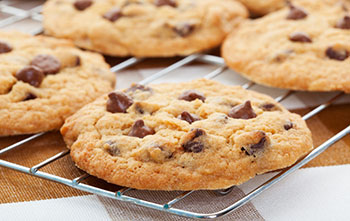More Health and Nutrition Bites
Related
Out of Arm's Reach
Oh, those office candy dishes. I have so many patients who have told me that their downfall is the little bowl of candy kept on their desk - or that of a colleague. Even if the dish isn't on their own desk, they tell me, every time they walk past that dish they just can't resist taking a candy or two.
Smaller bowls and serving spoons means smaller portions
My mom loves ice
cream and eats it pretty much every night. I'm not so sure that she'll be very
happy with my telling you this but it wouldn't be the first time that I have
done something wrong that my mother had to correct me for. She has lived a
pretty healthy life and while I chide her for having a variety of choices of
frozen delights in her freezer a small bowl of ice cream does make her happy.
Cut calories by planning ahead
When patients ask me to help them to lose weight, one of the first things I do is ask them what they eat for breakfast and lunch. Unfortunately, the vast majority of them do not take their lunch to work, but instead go out and buy their lunch. They might go to the cafeteria in their building or the Subway down the block - or they might go to a sit down restaurant.
Health & Nutrition Bites
Get the latest health and diet news - along with what you can do about it - sent to your Inbox once a week. Get Dr. Gourmet's Health and Nutrition Bites sent to you via email. Sign up now!
Take a moment and eat less, even when you're hungry

So many factors outside of ourselves can influence what we eat, when, and how much. Just having snacks around can make you want to eat them (Bite, 9/18/13), and using larger plates or bowls can lead you to eat more, even if you know better (Bite, 10/06/06), the food isn't very good, or you're not even hungry. Worse yet, if you are hungry you're more likely to eat more and you're more likely to eat unhealthy food even when healthier options are available.
Researchers the world over are looking for ways to help people make better, healthier choices, even in the face of daily challenges like these. One technique that gets a fair amount of attention is known as "mindfulness." The idea of mindfulness is to help people pay attention to their internal feelings of hunger (and its opposite, satiety - the feeling of being satisfactorily full). The hope is that this attention to actual physical feelings may help disrupt the external cues that lead people to eat more and help them make better choices.
Researchers in the Netherlands designed a study (Appetite 2014;(75):40-45) to see how hunger levels, portion size, and a mindfulness exercise would interact. Could mindfulness overcome both internal cues (hunger) as well as external cues (portion size)?
Over 100 university students participated in what they were told would be two different studies and were held only in the hours between 2pm and 5pm (snack time!). Each student was assigned a cubicle and directed to listen to a 14-minute audio recording. They then used a computer to respond to questions about the audio recording as well as their mood, which included questions about how hungry they were. At that point they were informed that the first study was completed. For the "second" study the students were then served a portion of mini-sized chocolate chip cookies and a glass of water. They were told to eat as much as they wished and then to respond to a paper and pencil questionnaire about the cookies. After ten minutes any leftover cookies were removed and the student returned to the computer for another set of questions.
This was actually what is known as a "2 x 2" study and each student was randomly assigned to one of four conditions: the 14-minute recording was either the introduction to an audio book or a mindfulness exercise (which never actually mentioned the words "mindfulness" or "meditation"), and there were two different portion sizes of the cookies (small vs. large). Thus the four conditions were: audio book & small portion, audio book & large portion, mindfulness exercise & small portion, and mindfulness exercise & large portion.
The researchers were surprised to see that regardless of what type of audio the students listened to, they always ate more cookies when they received the larger portion size. As you might expect, those who reported themselves to be more hungry also ate more than those who were not as hungry - but not when they listened to the mindfulness audio. It would appear that the mindfulness audio led hungrier participants to be satisfied with a fewer number of cookies.
What this means for you
I don't think it's realistic to think that people are going to sit through a 14-minute guided meditation every time they're presented with food. That said, it is reasonable to take a moment to tune in to your body before you eat: you're more likely to notice when you're satisfied.
First posted: March 5, 2014
